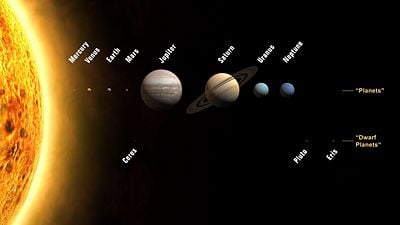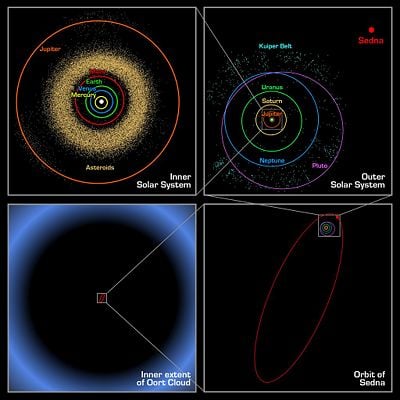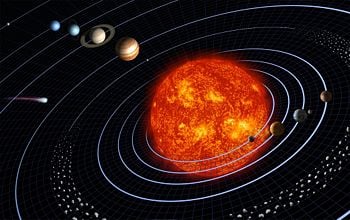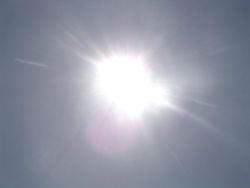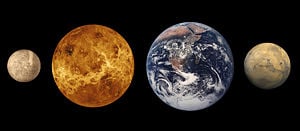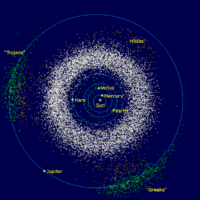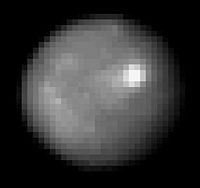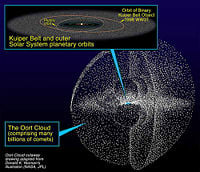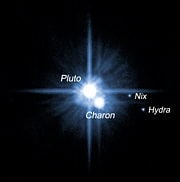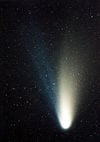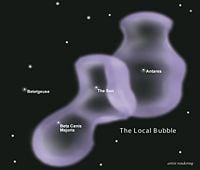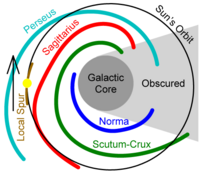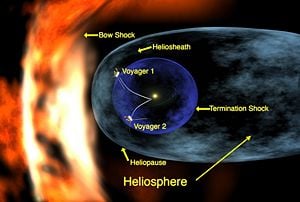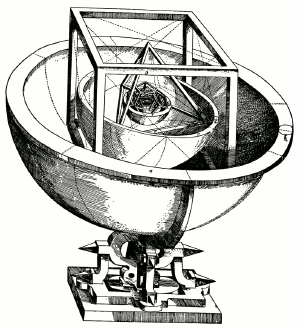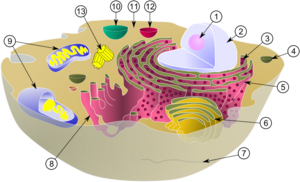The Solar system (or solar system)[1] is the home stellar system for human beings and all known forms of life. The solar system comprises the Sun, all the objects gravitationally bound to it, and the heliosphere, an enormous magnetic bubble enclosing most of the known solar system, including the solar wind and the entire solar magnetic field. Objects bound gravitationally to the Sun include eight planets, their 165 known moons,[2] at least three dwarf planets (including Pluto) with their four known moons, and billions of small bodies, classified primarily as asteroids, meteoroids, or comets.
In broad terms, the solar system comprises regions starting with the Sun and extending outward from there successively to:
- four terrestrial inner planets
- the asteroid belt of small rocky bodies
- four gas giant outer planets
- the Kuiper belt of icy objects
- the scattered disc
- the heliopause
- the hypothetical Oort cloud
All solar system objects are immersed in either the solar plasma, known as the solar wind, the interstellar plasma of the Milky Way galaxy, or a mixture of the two in a region lying just inside the heliopause, the diaphonous boundary of the heliosphere.
The eight planets, in order of their distances from the Sun, are: Mercury, Venus, Earth, Mars, Jupiter, Saturn, Uranus, and Neptune. Six of the eight planets are in turn orbited by natural satellites, usually termed "moons" after Earth's Moon, and each of the outer planets is encircled by planetary rings of dust and other particles. All of the planets, including the earth are surrounded by a teardrop shaped magnetosphere generated by the interaction of the magnetic field of the solar wind with that of each planet. All the planets except Earth are named after gods and goddesses from Greco-Roman mythology.
The solar system's position in the Milky Way galaxy and the Earth's position in the solar system are remarkably well-suited for the emergence and sustenance of life on Earth. The solar system occupies the Milky Way galaxy's relatively narrow "habitable zone" where the intensity of gamma rays, x-rays, and other radiation from surrounding stars is not too great to block the development of life by sterilizing planetary surfaces. This zone is comfortably removed from the intense concentration of stars closer to the galactic center, but not too close to the outer margins of the galaxy where there are not enough of the heavier elements to support formation of planets.[3][4] Within the solar system, the Earth is neither so close to the sun as to be too hot for life nor so far away as to be too cold. Had the Earth been much closer to the Sun or much farther away, life would not have arisen on the planet.
Historically, the solar system has been the key performer in the greatest and grandest show on earth, the drama of the sky with the sun moving across it each day and with the fixed stars of the constellations providing each night a slowly moving backdrop against which the more agile moon, and five visible planets—Mercury, Venus, Mars, Jupiter, and Saturn—performed their routines. Massive monuments—such as Stonehenge in England and pyramids in Egypt and the Americas—attest to ancient peoples' profound efforts to observe and predict movements of the solar bodies, and the active fields today of both astrology and solar astronomy demonstrate the continued importance of the solar system in human life. In western cultures, the names of the days of the week are derived from names of the planets or the names of gods associated with them. The current solar system model with the powerful central sun guiding from afar the planets and other solid bodies and radiating the light and heat that sustain life itself embodies an archetype that has been adopted into other fields.
Overview
The principal component of the solar system is the Sun (astronomical symbol ![]() ); a main sequence G2 star that contains 99.86 percent of the system's known mass and dominates it gravitationally.[5] Because of its large mass, the Sun has an interior density high enough to sustain nuclear fusion, releasing enormous amounts of energy, most of which is radiated into space in the form of electromagnetic radiation, including visible light. Jupiter and Saturn, the two largest bodies orbiting the Sun, account for more than 90 percent of the system's remaining mass (the postulated Oort cloud, should its existence be confirmed, would also hold a substantial percentage).[6]
); a main sequence G2 star that contains 99.86 percent of the system's known mass and dominates it gravitationally.[5] Because of its large mass, the Sun has an interior density high enough to sustain nuclear fusion, releasing enormous amounts of energy, most of which is radiated into space in the form of electromagnetic radiation, including visible light. Jupiter and Saturn, the two largest bodies orbiting the Sun, account for more than 90 percent of the system's remaining mass (the postulated Oort cloud, should its existence be confirmed, would also hold a substantial percentage).[6]
Most objects in orbit around the Sun lie within the same shallow plane, called the ecliptic, which is roughly parallel to the Sun's equator. The planets lie very close to the ecliptic, while comets and Kuiper belt objects often lie at significant angles to it. All of the planets—and most other objects—orbit with the Sun's rotation in a counterclockwise direction as viewed from a point above the Sun's north pole. There is a direct relationship between how far away a planet is from the Sun and how quickly it orbits (Kepler's laws of planetary motion). Mercury, with the smallest orbital circumference, travels the fastest, while Neptune, being much farther from the Sun, travels slower.
A planet's distance from the Sun varies in the course of its year. Its closest approach to the Sun is known as its perihelion, while its farthest point from the Sun is called its aphelion. Though planets follow nearly circular orbits, with perihelions roughly equal to their aphelions; many comets, asteroids and objects of the Kuiper belt follow highly elliptical orbits, with large differences between perihelion and aphelion.
Astronomers most often measure distances within the solar system in astronomical units (AU). One AU is the average distance between the Earth and the Sun, or roughly 149,598,000 kilometers (93 million miles). Pluto is roughly 38 AU from the Sun, while Jupiter lies at roughly 5.2 AU.
Representing the planets and the sun as a unit solar system in a single graphic presents major challenges because both the individual bodies (diameters ranging from 5,000 to 1,390,000 kilometers) and the planets' distances from the sun (average orbital radii ranging from .4 to 38 AU) are so greatly varied. As a result, many representations of the solar system distort the planetary orbits, with equal spacing between each object. In actuality, the general pattern is that the farther a planet—or a belt—is from the Sun, the greater the distance between it and the previous orbit. Attempts have been made to find a correlation between these distances (an early one was Bode's Law), but to date there is no accepted theory that explains the respective orbital distances.
Classification of solar system bodies
A planet, as defined by the IAU General Assembly on August 24, 2006, is any body in orbit around the Sun that (a) has enough mass to form itself into a near-spherical shape, and (b) has cleared or captured its immediate neighborhood of all smaller objects. Eight objects in the solar system currently meet these criteria: Mercury, Venus, Earth, Mars, Jupiter, Saturn, Uranus, and Neptune.
The IAU also used the term dwarf planet, a newly defined class of solar system bodies. The key difference between planets and dwarf planets is that while both are required to orbit the Sun and be of large enough mass that their own gravity pulls them into a nearly round shape, dwarf planets are not required to “clear their neighborhood” of other celestial bodies. Three objects in the solar system are currently included in this category. They are: Pluto, the largest known Kuiper belt object; Ceres, the largest object in the asteroid belt; and the scattered disc object Eris. The IAU is evaluating other known objects to see if they fit within the definition of dwarf planets. The most likely candidates are some of the larger asteroids and several trans-Neptunian objects.
The remaining objects in the solar system were classified as small solar system bodies (SSSB). The IAU used the term SSSB to describe solar system objects that are neither planets nor dwarf planets.
- All other objects ... orbiting the Sun shall be referred to collectively as "Small Solar System Bodies" ... These currently include most of the Solar System asteroids, most Trans-Neptunian Objects (TNOs), comets, and other small bodies.[7]
As of 2006, the IAU considers the following bodies to be SSSBs:
- all asteroids except Ceres
- all centaurs
- all trans-Neptunian objects, including Kuiper belt and scattered disc objects, with the exception of Pluto and Eris
- all comets
Formation
The currently accepted view regarding the formation of the solar system, called the nebular hypothesis, was first proposed in 1755 by Immanuel Kant and independently formulated by Pierre-Simon Laplace.[8] According to this hypothesis, the solar system was formed from the gravitational collapse of a gaseous cloud called the solar nebula. It had a diameter of 100 AU and was two to three times the mass of the Sun. Over time, a disturbance (possibly a nearby supernova) squeezed the nebula, pushing matter inward until gravitational forces overcame the internal gas pressure and it began to collapse. As the nebula collapsed, it began to spin faster (based on the conservation of angular momentum), and it became warmer. As the competing forces associated with gravity, gas pressure, magnetic fields, and rotation acted on it, the contracting nebula began to flatten into a spinning protoplanetary disk, with a gradually contracting protostar at the center.
From this cloud of gas and dust, the various planets formed. The inner solar system was too warm for volatile molecules like water and methane to condense, so the planets that formed there were relatively small (comprising only 0.6 percent of the mass of the disc) and composed largely of compounds with high melting points, such as silicates and metals. These rocky bodies eventually became the terrestrial planet. Farther out, the gravitational effects of Jupiter made it impossible for various protoplanetary objects to come together, leaving behind the asteroid belt. Still farther out, beyond the frost line, Jupiter and Saturn developed as large gas giants. Uranus and Neptune captured much less gas and are known as ice giants, because their cores are believed to be made mostly of ice—that is, hydrogen compounds.
The gas giants were massive enough to retain a "primary atmosphere" of hydrogen and helium captured from the surrounding solar nebula. The terrestrial planets eventually lost their retained hydrogen and helium, and subsequently generated their own "secondary atmospheres" through volcanism, comet impacts, and, in the case of the Earth, the emergence and development of life.
After about 100 million years, the pressure and density of hydrogen in the center of the collapsing nebula became high enough for the protosun to begin thermonuclear fusion, which increased until hydrostatic equilibrium was achieved. The young Sun's solar wind then cleared away all the gas and dust in the protoplanetary disk, blowing it into interstellar space, thus ending the growth of the planets.
There are still many unresolved issues in this view of the formation of the solar system. For instance, any proposed theory needs to explain mass and compositional distribution and orbital characteristics of all solar system bodies based on astronomical observations and evidence gathered from meteorites and interplanetary dust.
Sun
The Sun is the solar system's parent star, and far and away its chief component. It is classified as a moderately large yellow dwarf. This name, however, is misleading, because on the scale of stars in our galaxy, the Sun is rather large and bright. Stars are classified based on their position on the Hertzsprung-Russell diagram, a graph that plots the brightness of stars against their surface temperature. Generally speaking, the hotter a star is, the brighter it is. Stars that follow this pattern are said to be on the "main sequence," and the Sun lies right in the middle of it. This has led many astronomy textbooks to label the Sun as "average," although stars brighter and hotter than it are rare, whereas dimmer and cooler stars are common. The vast majority of stars are dim red dwarfs, though they are under-represented in star catalogs because we can observe only those that are relatively close to the Sun.
According to current theories of stellar evolution, the Sun's position on the main sequence means that it is in the "prime of life" for a star. In other words, it has not yet exhausted its store of hydrogen for nuclear fusion, and thus it has not been forced (as older red giants must) to fuse more inefficient elements such as helium and carbon. As it ages, the Sun is growing increasingly bright. Early in its history, it was roughly 75 percent as bright as it is today.[9] Calculations of the ratios of hydrogen and helium within the Sun suggest it is roughly halfway through its life cycle and will eventually begin moving off the main sequence—becoming larger, brighter, and redder, and becoming a red giant in about five billion years.
The Sun is a “population I” star—meaning that it is fairly new in galactic terms, having been born in the later stages of the universe's evolution. As such, it contains far more elements heavier than hydrogen and helium (metals, in astronomical parlance) than older, population II stars, such as those found in globular star clusters. Because elements heavier than hydrogen and helium were formed in the cores of ancient and exploding stars, the first generation of stars had to die before the universe could be enriched with those elements. For this reason, the very oldest stars contain very little "metal," while stars born later have more. This high "metallicity" is thought to have been crucial for the Sun to develop a planetary system, because planets form from the accretion of metals.[10]
The Sun ejects the solar wind, a pulsing stream of electrons, ions, neutral atoms, and magnetic fields, at speeds greater than 2 million kilometers per hour. It thus creates a very tenuous "atmosphere" (the heliosphere), that permeates the solar system for at least 100 AU. This environment is known as the interplanetary medium. Small quantities of cosmic dust (some of it arguably interstellar in origin) are also present in the interplanetary medium and are responsible for the phenomenon known as zodiacal light. The influence of the Sun's rotating magnetic field on the interplanetary medium creates one of the largest structures in the solar system: the heliospheric current sheet.[11]
Inner planets
The four inner (or terrestrial) planets are characterized by their dense, rocky composition, few or no moons, and lack of ring systems. They are composed largely of minerals with high melting points, such as silicates, that form their solid crusts and semi-liquid mantles. In addition, metallic dust grains such as iron form the cores of these planets. Three of the four inner planets have atmospheres. All have impact craters, and all but one possess tectonic surface features, such as rift valleys and volcanoes. The term inner planet should not be confused with inferior planet, which designates planets that are closer to the Sun than the Earth is (namely, Mercury and Venus).
Mercury
Mercury (0.4 AU), the closest planet to the Sun, is also the least massive of the planets, at only 0.055 of Earth's mass. Mercury has a very thin atmosphere, consisting of atoms blasted off its surface by the solar wind. Mercury is so hot that these atoms quickly escape into space. Thus, in contrast to the Earth and Venus, which have stable atmospheres, Mercury's atmosphere is constantly being replenished.[12] Mercury is surrounded by extremely small amounts of helium, hydrogen, oxygen, and sodium. This envelope of gases is so thin that the greatest possible atmospheric pressure (force exerted by the weight of gases) on Mercury would be about 2 x 10-12 kg/cm2 (3 x 10-11 psi). The atmospheric pressure on Earth is about 1.03 kg/cm2 (14.7 psi).[13] It has no natural satellites, and, to date, no observed geological activity other than that produced by impacts. Its relatively large iron core and thin mantle have not yet been adequately explained. Some have postulated that its outer layers may have been stripped off by a giant impact, and that it was prevented from fully accreting by the Sun's gravity. The MESSENGER spacecraft should aid in resolving this issue when it arrives in Mercury's orbit in 2011.
Venus
Venus (0.7 AU), the first truly terrestrial planet, is of mass comparable to that of the Earth (0.815 of Earth mass) and has been called “Earth’s twin.” Like Earth, it possesses a substantial atmosphere, a thick silicate mantle around an iron core, and evidence of one-time internal geological activity, such as volcanoes. It is, however, much drier than Earth, its atmosphere is 90 times as dense, and it is composed overwhelmingly of carbon dioxide and sulfuric acid. Evidence suggests that the crust of Venus, unlike Earth's crust, is not divided into tectonic plates, but rather comprises a single, thick rind.[14] Venus has no natural satellite. Also, it is the hottest planet, despite being farther from the Sun than Mercury, with temperatures reaching more than 400 °C. This is most likely due to the large amount of greenhouse gases (gases that trap heat) in the atmosphere.
Earth
The largest and densest of the inner planets, Earth (1 AU) is the only planet known to have life. It is also the only one to demonstrate unequivocal evidence of current geological activity. Its liquid hydrosphere, unique among the terrestrial planets, is probably the reason Earth is also the only planet where multi-plate tectonics has been observed—because water acts as a lubricant for subduction.[15]
The Earth's atmosphere is radically different from that of the other terrestrial planets, having been altered by the presence of life to contain 21 percent free oxygen. Its satellite, the Moon, is unusually large compared with the size of the Earth, causing significant effects on Earth such as ocean tides. In addition, the relative sizes and distances of the Moon and Sun enable us to observe a total solar eclipse. Earth's magnetic field protects its atmosphere from interacting with the solar wind, except in the vicinity of the poles where a variable influx of charged particles from the solar wind at times generates the shimmering Northern and Southern Lights.
Mars
Mars (1.5 AU), at only 0.107 of Earth's mass, is less massive than either Earth or Venus. It possesses a tenuous atmosphere of carbon dioxide. Its surface, peppered with vast volcanoes and rift valleys such as Valles Marineris, shows that it was once geologically active and recent evidence suggests this may have continued until relatively recently.[16] Mars possesses two tiny moons, Deimos and Phobos, thought to be captured asteroids. Evidences from Martian meteorites, spacecraft observations, and rover experiments suggest that Mars may have had liquid water in the past, and some think that Mars may have harbored some primitive forms of life as well.
Asteroid belt
Asteroids are mostly small solar system bodies that are composed in significant part of rocky, nonvolatile minerals. The main asteroid belt occupies an orbit between Mars and Jupiter, between 2.3 and 3.3 AU from the Sun. It is thought to consist of pieces that, due to the gravitational interference of Jupiter, failed to coalesce into a small terrestrial planet.
Asteroids range in size from hundreds of kilometers in diameter down to dust particles. All asteroids save the largest, Ceres, are classified as small solar system bodies. A number of other asteroids—such as Vesta and Hygeia—could potentially be reclassified as dwarf planets if it can be conclusively shown that they are spherical. The asteroid belt contains tens of thousands—and potentially millions—of objects over one kilometer in diameter.[17] Despite their large numbers, the total mass of the main belt is unlikely to be more than a thousandth of the Earth's mass.[18] In contrast to its various depictions in science fiction, the main belt is very sparsely populated—spacecraft routinely pass through it without incident. Asteroids with a diameter of less than 50 meters are called meteoroids.
Ceres
Ceres (2.77 AU) is the largest astronomical body in the asteroid belt and the only known dwarf planet in this region. It has a diameter of slightly under 1,000 kilometers—large enough for its own gravity to pull it into a spherical shape. Ceres was considered a planet when it was discovered in the nineteenth century, but it was reclassified as an asteroid when further observations revealed additional asteroids. Its location coincides with what is predicted by Bode's Law.[19]
Asteroid groups
Asteroids in the main belt are subdivided into asteroid groups and families, based on their specific orbital characteristics. Asteroid moons are asteroids that orbit larger asteroids. They are not as clearly distinguished as planetary moons, sometimes being almost as large as their partners. The asteroid belt also contains main-belt comets,[20] which may have been the source of Earth's water.
Trojan asteroids are located in either of Jupiter's "Lagrange points," which are gravitationally-stable regions leading and trailing the planet in its orbit. The term "Trojan asteroids" is also sometimes used for asteroids in the Lagrange points of other planets as well.
The inner solar system is also dusted with rogue asteroids, many of which cross the orbits of the inner planets.
Outer planets
The four outer planets, or gas giants, (sometimes called Jovian planets) are so large that they collectively make up 99 percent of the mass known to orbit the Sun. Jupiter and Saturn are true giants, at 318 and 95 Earth masses, respectively, and composed largely of hydrogen and helium. Uranus and Neptune are substantially smaller, being only 14 and 17 Earth masses, respectively. Their atmospheres contain a smaller percentage of hydrogen and helium, and a higher percentage of "ices," such as frozen water, ammonia, and methane. For this reason some astronomers have suggested putting them in a separate category—"Uranian planets" or "ice giants." All four outer planets exhibit orbital debris rings, although only the ring system of Saturn is easily observable from Earth. The term outer planet should not be confused with superior planet, which designates all planets that lie outside Earth's orbit (thus consisting of the outer planets plus Mars).
Jupiter
Jupiter (5.2 AU), at 318 Earth masses, is 2.5 times the mass of all the other planets put together. Its composition of largely hydrogen and helium is not very different from that of the Sun. Jupiter's strong internal heat creates a number of semi-permanent features in its atmosphere, such as cloud bands and the Great Red Spot. Three of its 63 satellites—Ganymede, Io, and Europa—share elements in common with the terrestrial planets, such as volcanism and internal heating. Ganymede has a larger diameter than Mercury.
Saturn
Saturn (9.5 AU), famous for its extensive ring system, has many qualities in common with Jupiter, including its atmospheric composition, though it is far less massive, being only 95 Earth masses. Two of its 49 moons, Titan and Enceladus, show signs of geological activity, though they are largely made of ice. Titan, like Ganymede, is larger than Mercury; it is also the only satellite in the solar system with a substantial atmosphere.
Uranus
Uranus (19.6 AU), at 14 Earth masses, is the lightest of the outer planets. Uniquely among the planets, it orbits the Sun on its side; its axial tilt lies at over 90 degrees to the ecliptic. Its core is remarkably cooler than that of the other gas giants (though it is still several thousand degrees Celsius) and radiates very little heat into space. Uranus has 27 satellites, the largest being Titania, Oberon, Umbriel, Ariel, and Miranda.
Neptune
Neptune (30 AU), though slightly smaller than Uranus, is denser and slightly more massive, at 17 Earth masses. It radiates more internal heat than Uranus, but not as much as Jupiter or Saturn. Its peculiar ring system is composed of a number of dense "arcs" of material separated by gaps. Neptune has 13 moons. The largest, Triton, is geologically active, with geysers of liquid nitrogen.
Edgeworth-Kuiper belt
The area beyond Neptune, sometimes referred to as the "outer solar system" or the "trans-Neptunian region," is still largely unexplored.
This region's first formation, which actually begins inside Neptune's orbit, is called the Edgeworth-Kuiper belt (or simply, Kuiper belt). This belt is a great ring of debris similar to the asteroid belt, but it is composed mainly of ice and is far greater in extent, lying between 30 and 50 AU from the Sun. This region is thought to be the place of origin for short-period comets, such as Halley's comet. Though it is composed mainly of small solar system bodies, many of the largest Kuiper belt objects could soon be reclassified as dwarf planets. There are estimated to be over 100,000 Kuiper belt objects with a diameter greater than 50 kilometers; however, the total mass of the Kuiper belt is relatively low, perhaps barely equaling the Earth's mass.[21] Many Kuiper belt objects have multiple satellites, and most have orbits that take them outside the plane of the ecliptic.
The Kuiper belt can be roughly divided into two regions:
- The "resonant" belt, consisting of objects whose orbits are in some way linked to that of Neptune (orbiting, for instance, three times for every two Neptune orbits, or twice for every one). It actually begins within the orbit of Neptune itself.
- The "classical" belt, consisting of objects that don't have any resonance with Neptune. It extends from roughly 39.4 AU to 47.7 AU.
Pluto and Charon
From 1930 to 2006, Pluto (39 AU average), one of the largest known Kuiper belt objects, was considered the solar system's ninth planet. In 2006, however, the International Astronomical Union (IAU) created an official definition of a planet[22] that disqualified Pluto as a planet. As a result, Pluto was reclassified as a dwarf planet.[22] Pluto has a relatively eccentric orbit, inclined 17 degrees to the ecliptic plane and ranging from 29.7 AU from the Sun at perihelion (within the orbit of Neptune) to 49.5 AU at aphelion. Prior to the 2006 redefinitions, Charon was considered a moon of Pluto, but in light of the redefinition, it is unclear whether Charon will continue to be classified as Pluto's moon or as a dwarf planet itself. Charon does not orbit Pluto—rather, both bodies orbit a barycenter of gravity in empty space, making Pluto-Charon a binary system. Two much smaller moons, Nix and Hydra, orbit Pluto and Charon.
Kuiper belt objects that, like Pluto, possess a 3:2 orbital resonance with Neptune—that is, they orbit twice for every three Neptunian orbits—are called Plutinos. Other Kuiper belt objects have different resonant orbits (such as 2:1, 4:7, 3:5) and are grouped accordingly. The remaining Kuiper belt objects, in more "classical" orbits, are classified as Cubewanos.
Comets
Comets are small solar system bodies (usually only a few kilometers across) containing large amounts of volatile ice and tracing highly eccentric orbits. They generally have a perihelion within the orbit of the inner planets and an aphelion far beyond Pluto. When a comet approaches the Sun, its icy surface begins to sublimate, or boil away, creating a coma—a long tail of gas and dust that is often visible with the naked eye.
There are two basic types of comets:
- Short-period comets, with orbits less than two hundred years
- Long-period comets, with orbits lasting thousands of years
Short-period comets are believed to originate in the Kuiper belt, while long period comets, such as Hale-Bopp (pictured), are thought to originate in the Oort cloud. Some comets with hyperbolic orbits may originate outside the solar system. Old comets that have had most of their volatiles driven out by solar warming are often categorized as asteroids (likely to be D-type asteroids).
Centaurs are icy, comet-like bodies that have less eccentric orbits, so that they remain in the region between Jupiter and Neptune. The first centaur to be discovered, 2060 Chiron, has been called a comet because it was found to develop a coma just as comets do when they approach the Sun.[23]
Scattered disc
Overlapping the Kuiper belt but extending much further outward is what is called the scattered disc. Scattered disc objects are believed to have been originally native to the Kuiper belt but were ejected into erratic orbits in the outer fringes by the gravitational influence of Neptune's outward migration. Most scattered disc objects have perihelia within the Kuiper belt but aphelia as far as 150 AU from the Sun. Their orbits are also highly inclined to the ecliptic plane, and are often almost perpendicular to it. Some astronomers, such as Kuiper belt co-discoverer David Jewitt, consider the scattered disc to be merely another region of the Kuiper belt, and they describe scattered disc objects as "scattered Kuiper belt objects."[24]
Eris
Eris (68 AU average) is the largest known scattered disc object. It was the cause of the most recent debate about what constitutes a planet, because it is at least five percent larger than Pluto, with an estimated diameter of 2,400 kilometers (1,500 miles). It is now the largest of the known dwarf planets.[25] It has one moon named Dysnomia.
This object has many similarities with Pluto. Its orbit is highly eccentric, with a perihelion of 38.2 AU (roughly Pluto's distance from the Sun) and an aphelion of 97.6 AU. Also, the orbit is steeply inclined to the ecliptic plane, at 44 degrees, more so than any known object in the solar system except for the newly discovered object 2004 XR190(also known as "Buffy").[26] It is believed to consist largely of rock and ice.[27]
Farthest regions
The point at which the solar system ends and interstellar space begins is not precisely defined, because the solar system's outer boundaries are delineated by two separate forces: the solar wind and the Sun's gravity. The solar wind extends to a point roughly 130 AU from the Sun, whereupon it surrenders to the surrounding environment of the interstellar medium. It is generally accepted, however, that the Sun's gravity holds sway over the hypothetical Oort cloud. This cloud, conceived of as a great mass of up to a trillion icy objects, is believed to be the source of all long-period comets. It is thought to surround the solar system like a shell from 50,000 to 100,000 AU beyond the Sun, or almost a quarter of the distance to the next star system. From this perspective, the vast majority of the solar system is completely unknown. Nonetheless, recent observations of the Solar system and other star systems have led to an increased understanding of what is or may be lying at its outer edge.[28]
Sedna
Sedna is a large, reddish Pluto-like object with a gigantic, highly elliptical orbit that takes it from about 76 AU at perihelion to 928 AU at aphelion and takes 12,050 years to complete. Mike Brown, who discovered the object in 2003, asserts that it cannot be part of the scattered disc or Kuiper Belt, as it has too distant a perihelion to have been affected by Neptune's migration. He and other astronomers consider it to be the first in an entirely new population—one that may include the object 2000 CR105, which has a perihelion of 45 AU, an aphelion of 415 AU, and an orbital period of 3,420 years.[29] Sedna is very likely a dwarf planet, though its shape has yet to be determined with certainty.
Heliopause
The solar wind, a stream of ions, electrons, neutral matter, and magnetic fields emanating in great pulses from the sun, sustains the heliosphere, which is thought to be slightly teardrop shaped and to extend out from the sun to about 95 AU, or two and one half times the orbit of Pluto. The bubble's diaphonous edge begins at the termination shock—the point at which the solar wind is significantly slowed by collision with opposing plasma winds of the interstellar medium. Here the wind condenses and becomes more turbulent in a region known as the heliosheath, which extends outward for a further 40 AU at its stellar-windward side, but stretches many times that distance in the opposite direction. The outer boundary of the sheath, the heliopause, is the region in which the solar wind is fully overcome by the interstellar galactic wind.[30] Beyond the heliopause, at around 230 AU, the interstellar plasma registers the approach of the solar system in the form of the bow shock—a plasma "wake" generated by the Sun as it travels through the Milky Way.[31]
Galactic context
The solar system is located in the Milky Way galaxy, a barred spiral galaxy with a diameter estimated at about 100,000 light years containing approximately 200 billion stars. Our Sun resides in one of the Milky Way's outer spiral arms, known as the Orion Arm or Local Spur.[32] The immediate galactic neighborhood of the solar system is known as the Local Fluff, an area of dense cloud in an otherwise sparse region known as the Local Bubble, an hourglass-shaped cavity in the interstellar medium, roughly three hundred light years across. The bubble is suffused with high-temperature plasma that suggests it is the product of several recent supernovae.[33]
Estimates place the solar system at between 25,000 and 28,000 light-years from the galactic center. Its speed is about 220 kilometers per second, and it completes one revolution every 226 million years. It appears to have a very remarkable orbit—one that is both extremely close to being circular, and at nearly the exact distance at which the orbital speed matches the speed of the compression waves that form the spiral arms.
The apex of solar motion—that is, the direction in which the Sun is heading—is near the current location of the bright star, Vega. At the galactic location of the solar system, the escape velocity with regard to the gravity of the Milky Way is about 1,000 kilometers per second.
Extrasolar planets
Until 1994, the solar system was the only known example of a stellar system in which a planet or planets orbit around a star. Since that first discovery, the subsequent discovery of more than 200 extrasolar planets has led to the term "solar system" being applied generically to all stellar systems. Technically, however, it should strictly refer to Earth's system only, as the word "solar" is derived from the Sun's Latin name, Sol. Other stellar systems or planetary systems are usually referred to by the names of their parent star, such as "the Alpha Centauri system" or "the 51 Pegasi system."
Studies of extrasolar systems have shown that the vast majority discovered so far are markedly different from the solar system. For instance, many extrasolar planetary systems contain a "hot Jupiter"[34]—a planet of size comparable to Jupiter, that nonetheless orbits very close to its star (for instance, at 0.05 AU). It has been hypothesized that while the giant planets in these systems probably formed in the same relative place as the gas giants in Earth's solar system did, the extrasolar giant planets may have migrated inward toward their parent star and along the way caused the destruction or ejection from the system of any existing smaller planets. The apparent prevalence of hot Jupiters among the extrasolar planets discovered so far may be an artifact of a skewed data set arising simply because close-in giant planets are the easiest extrasolar planets to detect. In coming years, it is quite possible that ongoing improvements in the capabilities for detecting extrasolar planets will lead to the discovery of stellar systems much more similar to our own.
Discovery and exploration
For many thousands of years, most people thought of the Earth as a stationary body at the center of the universe, and categorically different from the ethereal objects that moved through the sky. The conceptual advances of the seventeenth century—led by Nicolaus Copernicus, Galileo Galilei, Johannes Kepler, and Isaac Newton—gradually guided people to accept ideas such as (a) the Earth moves in an orbit around the Sun, (b) the planets are governed by the same laws as the Earth, and (c) the planets could therefore be similar to the Earth.
Telescopic observations
When astronomers first began using the telescope, they made unexpected discoveries about the solar system. For instance, Galileo Galilei discovered that the Moon was cratered, that the Sun was pocked with sunspots, and that Jupiter had four satellites in orbit around it. Giovanni Domenico Cassini and Christian Huygens followed on from Galileo's discoveries by discovering the rings of Saturn, and Saturn's moon Titan, respectively.
In 1682 Edmund Halley realized that repeated sightings of a comet were in fact recording the same object, returning regularly once every 75-76 years. This proved that comets were not atmospheric phenomena, as was previously thought, and provided the first evidence that objects other than planets orbited the Sun.
In 1781 William Herschel was looking for binary stars in the constellation of Taurus when he observed what he thought was a new comet. In fact, its orbit revealed that it was a new planet, Uranus, the first ever discovered with a telescope. In 1801 Giuseppe Piazzi discovered Ceres, a small world between Mars and Jupiter, that was initially considered a new planet. Subsequent discoveries of thousands of other small worlds in the same region led to their eventual reclassification as asteroids.
In 1846 discrepancies in the orbit of Uranus led many to suspect a large planet must be tugging at it from farther out. Urbain Le Verrier's calculations eventually led to the discovery of Neptune.
Further discrepancies in the orbits of the planets led Percival Lowell to conclude that yet another planet, "Planet X," must still be out there. After his death, his Lowell Observatory conducted a search, which ultimately led to Clyde Tombaugh's discovery of Pluto in 1930. Pluto was, however, found to be too small to have disrupted the orbits of the outer planets, and its discovery was therefore coincidental. Like Ceres, it was initially considered a planet, but after the discovery of many other similarly sized objects in its vicinity, it was eventually reclassified as an Edgeworth-Kuiper belt object.
Observations by spacecraft
Planets and small rocky bodies
Since the start of the space age, many explorations have been performed by unmanned space missions that have been organized and executed by various space agencies. The first probe to land on another solar system body was the Soviet Union's Luna 2, which impacted the Moon in 1959. Since then, increasingly distant planets have been reached, with probes landing on Venus in 1965, Mars in 1976, the asteroid 433 Eros in 2001, and Saturn's moon Titan in 2005. Spacecraft have also made close approaches to other planets—for instance, Mariner 10 passed Mercury in 1973.
The first probe to explore the outer planets was Pioneer 10, which flew by Jupiter in 1973. Pioneer 11 was the first to visit Saturn, in 1979. Following their launch in 1977, Voyagers 1 and 2 performed grand tours of the outer planets, with both probes passing Jupiter in 1979 and Saturn in 1980-1981. Voyager 2 then went on to make close approaches to Uranus in 1986 and Neptune in 1989. The Voyager probes are now far beyond Neptune's orbit, and astronomers anticipate that they will encounter the heliopause, which defines the outer edge of the solar system, in the next few years.[30]
All planets in the solar system have been visited to varying degrees by spacecraft launched from Earth, the last being Neptune in 1989. Through these unmanned missions, humans have been able to get close-up photographs of all the planets and, in the case of landers, perform tests of the soils and atmospheres of some.
No Kuiper belt object has been visited by a manmade spacecraft. Launched on January 19, 2006, the New Horizons became the first manmade spacecraft designated to explore this area. This unmanned mission is scheduled to fly by Pluto in July 2015. Should it prove feasible, the mission will then be extended to observe a number of other Kuiper belt objects.[35]
Plasma
From the beginnings of space exploration, spacecraft have revealed magnetic fields, charged particles and electrical activity along with neutral atoms in what had been assumed to be empty space. Discovery of the Van Allen radiation belts surrounding the earth were an early clue that space was much more dynamic than could be known from the surface of the planet. Beyond these belts, spacecraft discovered a pulsing plasma stream, which was named the solar wind, and intermediate between the belts and the wind, earth's magnetopause where the influence of earth's magnetic field succumbed to the sun's magnetic field carried in the solar wind.
The story of the exploration of the solar system is incomplete without an appreciation of the extent to which exploration spacecraft are engaged in monitoring magnetic fields, charged particles, and current flows both in the vicinity of planets and in the great voids between them. In all their journeys, the exploration spacecraft have always detected the solar wind still streaming away from the sun. An important realization for life on planet earth is that the sun supports it by providing not only heat and light, but also protection from many potentially harmful cosmic rays (extremely high energy particles), which are diverted from deep penetration of the solar system by the plasma envelope of the heliosphere sustained by the solar wind.
At home in the solar system
To ancient peoples the sky was the home of gods and goddesses associated with what we today know as the Sun, the Moon, and the visible planets. Tracking the activities, the movements in the sky, of these deities was important for planning and conducting life activities, as evidenced by astrological systems practiced for centuries or even millenniums in places such as China, India, Mesopotamia, Egypt, Greece, Rome, and Central America. Each of these accorded central importance to the visible planets plus the Sun and the Moon, and several of these systems are still applied today. They were developed based on the assumption that the earth was the center about which the gods and goddesses moved through the sky.
In modern times, monotheistic religions and science have together severely undermined the mystery and primacy of the deities in the sky. Conceptually, the monotheistic religions have denied their existence, while science has explained them away and replaced them with inconceivably remote and totally lifeless bodies of plasma (the Sun), rock (the Moon, Mercury, Venus, and Mars), or gas (Jupiter and Saturn). The birth of the solar system as a distinct conceptual unit stripped of its mysterious gods and influence on human affairs traces back to the radical shift some four centuries ago from the earth-centered model of the cosmos to the sun-centered solar system cosmos.
One of the towering figures in that transition, the German astronomer Johannes Kepler, a Lutheran and still committed to the Aristotelian idea that the planets were moving on clear spheres, devised a model in which each planet moved on a sphere either circumscribed around or inscribed within one of the five Platonic solids, which were nested in an order that yielded orbital dimensions strikingly close to those determined by the astronomical methods available at the time. Kepler's proposal was one of the last serious attempts at producing a model of planetary motions that retained explicit association—in this case, through the Platonic ideal forms—with a higher realm of mystery and deity.
The solar system given to us by science, despite its lack of deity and mystery, has nonetheless claimed a new place of meaning in the human mind—as an archetypal model of organization that can be applied beyond the realms of astronomy. This model is one of relationships in which two or more elements sharing a common purpose interact as partners, with the dominant element assuming the position of the central subject partner while the other element or elements follow the lead of (orbit around) the subject and they all together create something new. For example, the solar system, which his given birth to both life and human beings, is something new that the planets together with the sun and all the moons are co-creating.
In the early twentieth century, the first effective working model of the hydrogen atom resembled a simplified miniature solar system with one "planet," an electron, orbiting at a great distance around a massive, central "sun," a proton. Although the resemblance was forced and the model was rather quickly replaced by a quantum shell model, the concept of a tiny solar system in an atom has embedded itself in society in the icon representing an atom and atomic energy; and the solar system model is still used for elementary instruction about atoms.
Many scientists decry the continued association of the atom with the solar system model because quantum models of the atom present a nucleus that is not orbited by electrons but rather is surrounded by a nebulous cloud of quantized probable electron locations described not as an orbit but as an orbital. Disregarding or remaining ignorant of such concerns, those who view the solar system as an archetype persist in seeing the atom as embodying the same archetype when they consider that the tiny, mobile electrons and the massive, dominant nucleus collaborate in producing a new creation, the atom.
A similar archetypal view can be applied as well to biological cells with their dominant nucleus orchestrating the amazingly complex metabolism carried out in the surrounding cytoplasm in a harmony of action that produces and maintains a functioning cell.
Similarly, within the human nuclear family, the parents and the children can be seen as occupying positions comparable respectively to those of the sun and the planets. Further, the parents in giving love, nurture, and guidance to the children are acting on the model of the sun gravitationally directing the earth while also providing earth with the heat and light essential for generating and sustaining life.
Viewed from yet another angle, the vertical order of the extended family generations running back from parents to grandparents and great grandparents and forward to children and grandchildren is similar to the astronomical vertical order mapped by taking the Sun to be in the position of the parents. "Generations" extending "back" from the Sun would be the center of the Milky Way galaxy about which the Sun orbits, and beyond that the massive supercluster pulling the Milky Way toward it. Generations extending "forward" from the Sun would be the planets in the position of children and the moons of planets in the position of grandchildren. Seeing such a harmony of pattern extending from the solar system to the family, the cell, and the atom can affirm the human sense of the connectedness of all things and of the solar system as home for the human family.
References and notes
- ↑ Capitalization of the name varies. The IAU, the authoritative body regarding astronomical nomenclature, specifies capitalizing the names of all individual astronomical objects (Solar System). However, the name is commonly rendered in lower case (solar system) including in the Oxford English Dictionary, Merriam-Webster's 11th Collegiate Dictionary, and Encyclopædia Britannica. All links retrieved August 13, 2007.
- ↑ Scott S. Sheppard, The Jupiter Satellite Page. Retrieved August 13, 2007.
- ↑ Donald Brownlee and Peter D. Ward, Rare Earth: Why Complex Life Is Uncommon in the Universe (New York: Springer-Verlag, 2001).
- ↑ Leslie Mullen, “Galactic Habitable Zones,” Astrobiology (May 18, 2001). Retrieved August 13, 2007.
- ↑ M. Woolfson, “The origin and evolution of the solar system,” Astronomy & Geophysics 41(1) (February 2000): 12-19. Retrieved August 13, 2007.
- ↑ L. S. Marochnik, L. M. Mukhin and R. Z. Sagdeev, “Estimates of mass and angular momentum in the Oort cloud,” Science 242 (Oct. 28, 1988): 547-550. Abstract available online. Retrieved August 13, 2007.
- ↑ “The Final IAU Resolution on the Definition of ‘Planet’ Ready for Voting,” International Astronomical Union Press Release (August 24, 2006). Retrieved August 13, 2007.
- ↑ T. J. J. “The past history of the Earth as inferred from the mode of formation of the Solar System.” Proceedings of the American Philosophical Society 48 (191) (Jan.-Apr. 1909): 119-128.
- ↑ J. F. Kasting, and T. P. Ackerman, “Climatic consequences of very high carbon dioxide levels in the Earth’s early atmosphere,” Science 234 (1986): 1383-1385.
- ↑ Charles H. Lineweaver, “An Estimate of the Age Distribution of Terrestrial Planets in the Universe: Quantifying Metallicity as a Selection Effect.” Retrieved August 13, 2007.
- ↑ Artist's conception of the heliospheric current sheet.
- ↑ Bill Arnett, Mercury. Retrieved August 13, 2007.
- ↑ Maria T. Zuber, NASA - Mercury. Retrieved August 13, 2007.
- ↑ P. Rincon, “Doubt cast on Venus catastrophe,” BBC News (March 16, 2006). Retrieved August 13, 2007.
- ↑ Simon Lamb, “Shear stresses on megathrusts: Implications for mountain building behind subduction zones.” Abstract available online from the American Geophysical Union. Retrieved August 13, 2007.
- ↑ D. Noever, “Modern Martian Marvels: Volcanoes?” NASA Astrobiology Magazine. Retrieved August 13, 2007.
- ↑ European Space Agency, “New study reveals twice as many asteroids as previously believed” (April 5, 2002). Available online from AlphaGalileo Foundation. Retrieved August 13, 2007.
- ↑ G. A. Krasinsky, E. V. Pitjeva, M. V. Vasilyev and E. I. Yagudina, “Hidden mass in the asteroid belt,” Icarus 158(1) (July 2002): 98-105. Abstract available online. Retrieved August 13, 2007.
- ↑ NASA, Student Acitvity—Scale Modeling of Vesta and Ceres in the Solar System,” Dawn Classroom Activities: History and Discovery of Asteroids. Retrieved August 13, 2007.
- ↑ Phil Berardelli, “Main-Belt Comets May Have Been Source of Earth’s Water,” SpaceDaily (March 23, 2006). Retrieved August 13, 2007.
- ↑ S. J. Kenyon and J. X. Luu, “Guest Accretion in the early Kuiper belt. I. Coagulation and velocity evolution,”] The Astronomical Journal (2003).
- ↑ 22.0 22.1 IAU 2006 General Assembly: Result of the IAU Resolution Votes,” International Astronomical Union (August 24, 2006). Retrieved August 13, 2007.
- ↑ Patrick Vanouplines, 1995, “Chiron biography.” Retrieved August 13, 2007.
- ↑ D. Jewitt, 2005, “The 1000 km scale KBOs.” Retrieved August 13, 2007.
- ↑ Michael Brown, “The discovery of
2003 UB313Eris, the10th planetlargest known dwarf planet.” Retrieved August 13, 2007. - ↑ Francis Reddy, “Tenth planet discovered,” Astronomy (July 30, 2005). Retrieved August 13, 2007.
- ↑ Michael Brown, 2005, “Dysnomia, the moon of Eris.” Retrieved August 13, 2007.
- ↑ Bill Arnett, [http://www.nineplanets.org/kboc.html “The Kuiper Belt and The Oort Cloud,”] Nineplanets.org. Retrieved August 13, 2007.
- ↑ Dave Jewitt, Sedna - 2003 VB12. Retrieved August 13, 2007.
- ↑ 30.0 30.1 NASA, "Voyager: The Interstellar Mission." Retrieved August 13, 2007.
- ↑ P. C. Frisch, "Astronomy Picture of the Day: The Sun's Heliosphere & Heliopause," NASA Astronomy Picture of the Day (June 24, 2002). Retrieved August 13, 2007.
- ↑ M. J. Rogers, M. Sadzinska, J. Szabelski, D. J.van der Walt and A. W. Wolfendale, “A comparison of cosmic-ray energy spectra in Galactic spiral arm and interarm regions,” Journal of Physics G: Nuclear Physics 14(8) (August 1988): 1147-1156. Retrieved August 13, 2007.
- ↑ “Near-Earth Supernovas,” Science@NASA (January 6, 2003). Retrieved August 13, 2007.
- ↑ Richard P. Nelson, John C. B. Papaloizou, Frédéric Masset, Willy Kley, "The migration and growth of protoplanets in protostellar discs," Monthly Notices of the Royal Astronomical Society 318(1): 18–36. Retrieved August 13, 2007.
- ↑ NASA, New Horizons NASA's Pluto-Kuiper Belt Mission. Retrieved August 13, 2007.
See also
- Planetary science
- Sun
- Planet
- Dwarf planet
- Asteroid
- Comet
- Meteorite
- Space weathering
External links
All links retrieved February 2, 2023.
- NASA's Solar System Exploration Site
- NASA/JPL Solar System
- The Nine Planets – Comprehensive solar system site by Bill Arnett
- SolStation: Stars and Habitable Planets
- SPACE.com: All About the Solar System
- The Solar System: The Major Planets: Planetary Data by Kryss Katsiavriades and Talaat Qureshi
- Solar System at Space Wiki
Credits
New World Encyclopedia writers and editors rewrote and completed the Wikipedia article in accordance with New World Encyclopedia standards. This article abides by terms of the Creative Commons CC-by-sa 3.0 License (CC-by-sa), which may be used and disseminated with proper attribution. Credit is due under the terms of this license that can reference both the New World Encyclopedia contributors and the selfless volunteer contributors of the Wikimedia Foundation. To cite this article click here for a list of acceptable citing formats.The history of earlier contributions by wikipedians is accessible to researchers here:
The history of this article since it was imported to New World Encyclopedia:
Note: Some restrictions may apply to use of individual images which are separately licensed.
